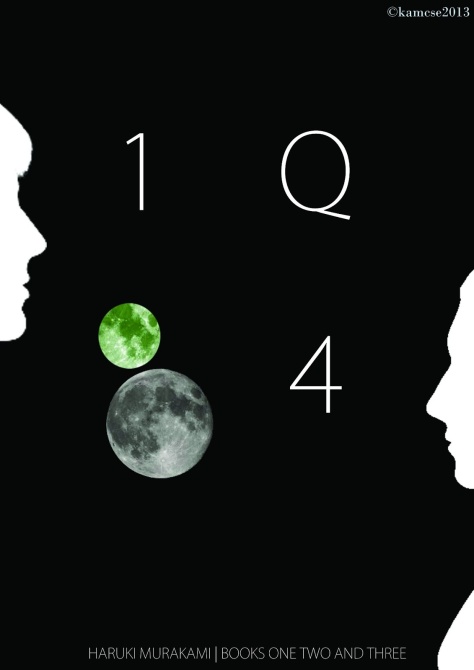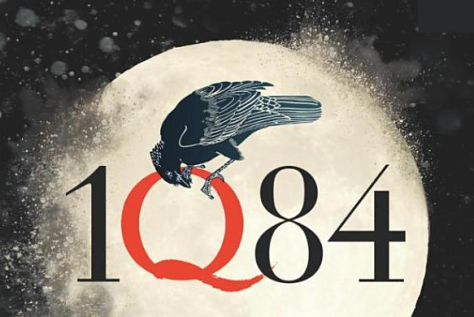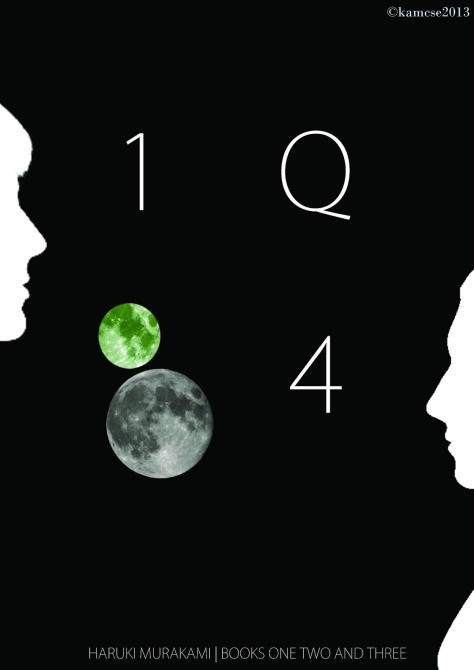1Q84
Book Three, Chapters 13-21
By Dennis Abrams
To Ushikawa:
While we have known that Ushikawa is not, by any means, an attractive man, we learn that to compensate for it, he has delved into learning and knowledge. We also learned that he has a wife and two daughters, although he and his wife have separated and he hasn’t seen his children in four years.
He begins his stakeout of Tengo’s building, taking an apartment on the ground floor and photographing everybody going in and out of the building. (He is also proving to be a liability to all concerned, although he is not yet aware of the danger. Given this, the Leader’s statement that sometimes individuals appear in 1Q84 who were never to appear there takes on a darker meaning – is Ushikawa such an unintended guest?
I love how Murakami is making us feel almost sorry for Ushikawa and his move back to “square one.”
And his playing with everyone’s time frame.
Ushikawa’s photos – the sadness on everyone’s face.
“Even if I left this world, I doubt anyone would notice. I would shout out from the dark, but no one would hear me. Still, I have to keep soldering on until I die, the only way I know how. Not a laudable sort of life, but the only life I know how to life.”
Ushikawa watches Fuka-Eri, What is she looking at/for above the electric pole? Her KNOWING that he is inside taking photos. The pain of her gaze.
The collector for the NDK shows up at Ushikawa’s door. Why isn’t he seen leaving the building?
Ushikawa sees Fuka-Eri leave Tengo’s apartment, and she looks him in the eyes as she leaves, unnerving him while at the same time moving him spiritually. He returns to the window in his apartment, watching Tengo’s building through a camera lens. As he watches people coming and going, he begins to question whether or not what he is seeing is real, AND, if it is real, does anything that goes on matter?
When Tengo returns, Ushikawa follows him to a bar and then around the neighborhood. He follows him to the playground, watches Tengo sitting on the slide and looking up and then, after he leaves, Ushikawa climbs up on to the slide to see what Tengo was looking at and, lo and behold, sees that there are two moons. He suddenly knows that something has gone very wrong, and thinks of “Air Chrysalis.”
Ushikawa watches Fuka-Eri as she once again takes her stuff and leaves Tengo’s apartment. Once again, she watches him, and once again, he is deeply affected by her. “When that girl left, she left behind this void. No, maybe not. Maybe she just showed me something that was already there, inside me.” Is he in love with her? How does she know he’s watching?
At the playground, he climbs the slide and sees the two moons. “It’s the world around me that’s gone crazy. And I have to find out why.”
And Aomame:
Aomame now understands that reason and logic do not exist in 1Q84. By December, she is clearly pregnant, and is more and more certain that the baby is Tengo’s child. “If I’m pregnant without having had sex, who could the man possibly be other than Tengo?”
She also comes to realize that she believes in God. She isn’t just praying like she was when she was younger, she actually believes. People get in the way of finding God, she understands, and realizes that to protect the baby she has to recognize that she believes in God.
Her dream of the room guarded by Buzzcut and Ponytail, her fear that they were after her baby. “If need be, she would have no problem pumping all the 9mm bullets she had into Ponytail and Buzzcut. The God that protected her was also, at times, a bloody God.”
The NDK fee collector returns, once again pounding on the door and calling out to her, but Aomame does not answer. She speaks by phone to the dowager and watches the playground.
The fee collector comes back but Aomame still does not answer. Eventually, the man leaves. She speaks by phone to the dowager, who warns her about the man who had been watching Willow House (Ushikawa) and raises the question of why such an “unusual looking man, “he sounds like a colorful circus clown” would be sent to do such a job. The Dowager tells Aomame that on the night of the thunderstorm, she lost her anger – just as Aomame had.
Aomame listens to Janacek’s “Sinfonietta” and watches the news twice a day. She also begins looking at herself in the mirror, and for the first time in her life, thinks of herself as pretty.
She sees a man sitting on the slide in the playground, and believes it to be Tengo. But she sees on closer inspection that it is not. She nicknames him Bobblehead (we know it’s Ushikawa), puts on a jacket and hat, and decides to follow him. She discovers the apartment building he goes near and sees Tengo’s surname on one of the buzzer charts.
Aomame returns to her own apartment and calls Tamaru, who is unhappy she has gone out of the apartment. She tells Tamaru about Bobblehead, and about Fuka-Eri’s father being the Leader. She requests that Tamaru find out if the Kawana in the apartment is Tengo, and to see how close Bobblehead is to figuring out what is going on. Aomame also says that if any harm should come to Tengo, she wants to take his place.
Her lack of progress in Proust. “It feels like I’m experiencing someone else’s dream. Like we’re simultaneously sharing feelings…”
And Tengo:
Tengo ends up at the playground. He sees both moons, and considers the idea that perhaps they are a special message for him and him alone. He gets up and leaves and goes back to his apartment to read the letter Fuka-Eri had written him. The letter explains that she left because she knew they were being watched, but by whom or why was not explained. How she knew this is also not explained. The crow that Fuka-Eri described comes back and to the balcony. She also describes being able to talk to the crow.
The next day, Tengo talks to Komatsu on the phone. Komatsu has much to tell Tengo, and they agree to meet that night at seven. They meet that night and Komatsu asks about Tengo’s novel. Komatsu also reveals Fuka-Eri is now home with the Professor, and the missing persons report has been withdrawn. Komatsu assures Tengo his name will not be made public. Komatsu also reveals that he had been kidnapped by Buzzcut and Ponytail, which is why he was missing for seventeen days. To get released, he agreed to stop any further publication of “Air Chrysalis”
“What a strange world. With each passing day, it’s getting harder to know how much is just hypothetical and how much is real.”
Kumi Adachi, the nurse from the sanatorium, calls Tengo late at night. Tengo’s father has died. Early the next morning, Tengo travels to the sanatorium to discover his father has apparently died of heart failure brought on by the coma. Tengo’s father had previously arranged for a simple funeral and cremation for himself. Tengo then meets with a lawyer to go over the papers his father left behind. This includes money and a single photograph. The photograph is of the family, when Tengo was a year or two old.
Tengo also discovers that his father wants to be cremated in his television fee collection uniform. Kumi tells Tengo that sometimes, his father used to tap on the bed railing, like he was knocking on a door.
————–
I was intrigued and slightly puzzled by the sudden shift of focus at the end of Chapter 17, the section starting “Of course, it wasn’t a child that Aomame saw…” It’s like a film that has been in close-up, but then the camera pulled back to show the big picture, a number of “ifs” — interesting choice.
From Strecher:
“If the metaphysical world is as real as the physical one (at least within the context of Murakami’s fictional world), so too the ‘sacred’ realm, as part of that metaphysical world, must be regarded as real. Ordinarily such a point would not need to be made with respect to Murakami, except that there is a natural inclination, particularly in ‘modern’ societies, to regard people who hear voices as mad. (It is an interesting point of irony that there is a greater tendency among people – especially those living in advanced industrialized societies – to place their faith in religious leaders whose faith is grounded in sacred writings rather than in direct sacred experience.) Perhaps this is because most organized religions exist at a comfortable distance from the direct experience of the ancient seer on whose teachings their belief system is founded. Then, too, it may be inevitable that industrialized people should be more comfortable with the sense of order that comes with organization and tradition.
But all religions must start somewhere, and if we think about the growth of some of the major ones – Judaism, Buddhism, Christianity, Islam, for instance – we note that they generally began with a charismatic leader who claims direct experience and contact with a deity or deities. Certainly this was true of Moses, Buddha, Jesus, and Mohammed. Even assuming that their experiences and instructions were preserved for a generation or two by disciples, fellow mystics or seers, eventually those teachings were codified, written down, and maintained by a priesthood whose ordained have little or no direct contact or experience with the deity/deities, but whose faith is grounded in the codified teachings themselves. This process it not confined only to the ancient religions; new religions and cults spring up regularly even into the present era, many of them offshoots of established religions (many Japanese cults, for instance, are variants of Buddhism, founded by leaders who claim direct mystical experiences). Invariably, tension is born between the established, textually based religions and the ‘new,’ experience- based derivatives, and religious history is filled with stories of burning or banishing as madmen or ‘heretics’ those who claim to have had a direct encounter with the deity. Joseph Campbell usefully describes these two phases of religious experience as those of the ‘shaman’ and the ‘priest.’:
‘The figure now in the primary role is the priest, who is an ordained official of the tribal or village deities; these are not of his personal experience. He is in the service of the society and its deities, for the priestly society. The shaman is an archaic danger. He represents the early mystic, one who has had the individual mystic experience and is supported by his familiars – his own special deities – whereas the priest is supported by and is in turn the supporter of the cultural deities. The two systems are inherently in conflict. The priest is the man of the book; the shaman is the man of the experience.’
What Campbell describes can also be expressed as the conflict between collective thought/experience and individual thought/experience. In the case of 1Q84, we see this best exemplified, sometimes explicitly, other times more subtly, in the conflict that comes to exist between what we will term true prophets, that is, those genuinely touched by the divine spark, and false prophets, who champion the sort of ‘myths’ of which Roland Barthes wrote, artificial constructs such as ‘morality’ and ‘justice,’ as well as religious and political ideological systems quite as though they represented absolute truth.
In fact, the structure of 1Q84 sets up those oppositions quite plainly, for divinely inspired characters are clearly marked with exceptional physical or mental qualities. Fukaeri, for instance, is marked physically; she is beautiful yet somehow lacks ‘balance’; physically she is small, but her breasts are unusually large and draw a great deal of attention. But most of all she seems simply artificial. ‘Her expression was devoid of the scent of life,’ Tengo reflects the first time he sees her. Other areas of her body, as we saw in the previous chapter, actually look as though they are not real. But Fukaeri is also ‘marked’ by her inability to communicate in the ordinary way, speaking in extremely short sentence, with virtually no intonation (difficult words are written in the text phonetically in katakana as a signal to the reader that they are more sounds to her than pictorial images or concepts). It is a point of humor that she always asks questions of Tengo ‘without the question mark’ (gimonfu o tsukezu ni).
In the context of our mythological analysis, we may associate Fukaeri’s difficulty in communicating through normal human channels as a sign that she is a direct receiver – the mouthpiece – of oracles, the first to hear the ‘voices’ of the gods (or of the Little People in this case) and to pass along what they have said. As with many oracles, however, these messages arrive in jumbled form – as riddles, as parables, in code – and are not intelligible to the uninitiated. Thus, the messages that emerge from Fukaeri must be interpreted by those with the gift of transposing the sublime into the everyday. Initially, Fukaeri’s ‘oracle’ is interpreted and transmitted in a primitive form by the teenage daughter of Professor Ebisuno, who provides refuge to Fukaeri after she has run away from the cult. The real task of interpreting and transmitting the contents of this oracle to the masses, however, falls to the Leader and, later, to his son Tengo.
Both Tengo and the Leader (who certainly is Tengo’s spiritual father, if not his actual, biological one) are marked as divine by their extraordinary physical size and strength, as well as their more intellectual gifts in language and reasoning. We recall that Tengo, upon reading Fukaeri’s story (as transposed by Ebiusno’s daughter), is taking by it in a way that he cannot ignore; the narrative has awakened something inside him, and when directed to rework the piece for publication, despite strong ethical misgivings, he finds that he cannot resist. Like Yoshiya [from the short story All God’s Children Can Dance], Tengo cannot deny the divine spark that he carries, nor can he escape his sacred task as a prophet, intermediary between humans and the gods. His editor Komatsu says much the same thing when he tells Tengo, ‘You’ll be the mediator, you’ll connect Fukaeri’s world with the real world.’ From the start, then, Tengo has been marked to replace the Leader, whose ability to interpret the words – the Will – of the gods (the Little People) through Fukaeri wanes as his physical body deteriorates. In the tradition of ancient animistic religions – including Shinto – the Leader performs the function of shaman, his experiences with the spirit world immediate and personal. As a holy man he intercedes between the earthly masses and the spirit world, interpreting the raw data transmitted through Fukaeri and transposing it into intelligible Law. And Tengo, in rewriting Fukaeri’s narrative for wider dissemination, has unwittingly already begun to take over the family business.
In mythological terms, if Tengo and the Leader are prophets and Fukaeri functions as oracular messenger of the gods, then Aomame fulfills the dual role of bringer and taker of life. Aomame at times strikes us as a series of paradoxes: she can be friendly and appealing, yet her grimace can cause children to soil themselves; she is a fitness instructor and nutrition expert who moonlights as a serial killer and whose best friend is a police officer; she detests the religion in which she was raised yet unconsciously appeals to that very same god when faced with sudden uncertainty. Aomame’s lack of consistency is physically marked by her breasts, which are of different size, symbolizing the two sides to her personality and her dual roles. She is a force of nature itself, monster and angel, bringer of death and (as mother to Tengo’s unborn child) giver of life. Even as Aomame uses her ice pick-like instrument to turn off the ‘life switch’ at the base of her victim’s brains, she zealously nurtures and protects the fragile and defenseless life that grows inside her. In fact, it is precisely for control of her womb – and thus control of her body itself – that the final conflict in this story will be fought out.
This leaves Ushikawa, the last of the characters I would identify as divinely marked, though readers may wish it were not so. Ushikawa, whose name means ‘bull river,’ is actually more of a doglike character, marked by his small stature and misshapen head. His appearance is particularly striking that he comes from a family of tall, well-proportioned, good-looking people. He alone is hideous, but is our best indication that he has been marked by the gods. Blessed with extraordinary instincts, a keen intellect, and a talent for finding things that are unfindable, Ushikawa enters the narrative as a temporary retainer for the Sakigake cult, which sends him to approach Tengo in order to rediscover the whereabouts of Fukaeri; later, in book 3, he is sent out to locate Aomame following the death of the Leader. However, while Ushikawa works for Sakigake, from a narratological point of view his role more closely resembles that of Nakata, whose task is to open the Gateway Stone and restore a sense of balance between the two sides. [SPOILER ALERT FOR THE REST OF THE PARAGRAPH!] Despite his unpleasant appearance, Ushikawa’s position is neither benevolent nor malevolent. This, however, is also why he must die; the balance must, temporary at least, be upset in order to break the stalemate and bring the conflict to a resolution. Like the Leader, Ushikawa is a necessary sacrifice.
The stakes in bringing about this reunification are considerable; they involve the establishment of the next generation of divinely sparked humans – beginning with Aomame and Tengo’s child – who have struggled their whole lives. Their task, which they must perform together or not at all, is to show the way by breaking free of the various ready-made narratives that have bound them until now.
As we have already seen, both Aomame and Tengo spent their childhoods under the care of parents who zealously adhered to rigid belief syste4ms. In Aomame’s case this took the form of evangelical Christianity, and she, too, was forced to follow these customs and rituals without question. Tengo was left in the hands of an equally zealous worshipper of the Japanese State – represented through NHK. His father’s loyalty to NHK is understandable; having returned to Japan from mainland Asia following World War II, with neither education nor family, Tengo’s father survived because he found employment – an actual home – with NHK.
Sincere as their parents may have been in their devotion to these belief systems, however, those systems ultimately prove unsuited to Aomame’s and Tengo’s needs, precisely because even as children their inner selves were intact; ready-made narratives such as organized religion and State ideology can only stunt their spiritual and emotional development. Their only hope of meaningful existence is thus to break free and continue to develop their own inner voices. As children, both Tengo and Aomame were pawns for their parents; as adults, it’s imperative that they live for themselves.
But do they? Herein, I think, Murakami sets a subtle trap for his readers, for while Aomame and Tengo may appear to have shaken off the shackles of their childhood restrictions and come into their own as adults, I would argue that, quite the contrary, in the process of escaping the evangelical roots in which they were brought up, both have run directly into the arms of a new manifestation of the same sort of ready-made narratives, in the form of the zealotry represented in the old woman and Komatsu. Aomame is still a pawn, an enforcer of the old woman’s campaign of vengeance against abusive men, meting out justice, to be sure, but whose justice and on whose terms? Tengo, similarly, is drawn into Komatsu’s game of revenge and humiliation against the pretensions of the literary and artistic community. Like Aomame, he got into the game for compelling reasons of his own, but in the end he serves as a mere tool advancing the agenda of Komatsu himself. Komatsu and the old woman, then, within the quasi-religious context of this discussion, represent merely one more pair of ‘false prophets,’ exploiting the gifts Tengo and Aomame possess to further their own schemes. Neither Komatsu nor the old woman are presented as evil per se; they are simply a new variation on an old theme.”
So what do you all think? Share your thoughts/comments/questions with the group!
My next post, Tuesday, November 4, the conclusion of 1Q84
Enjoy!




